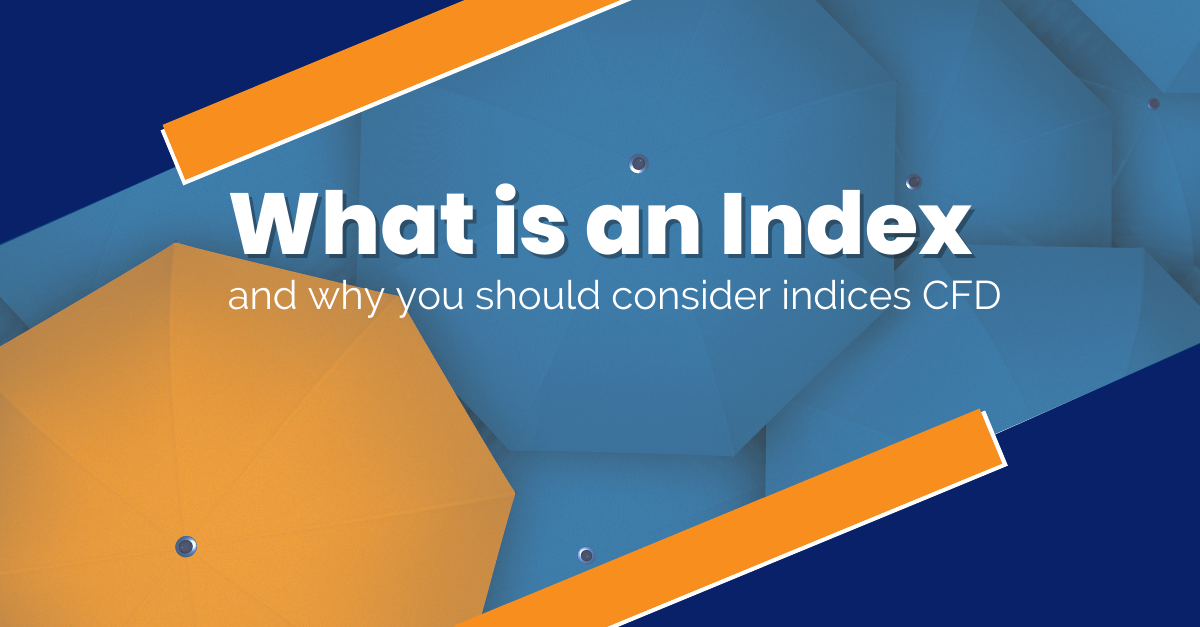What is an Index, and why you should consider indices CFD July 25, 2022

Index CFDs are a popular alternative to trading individual stocks, index futures or Exchange-Traded Funds (ETFs), because the instruments allow you to gain exposure portfolio to a particular index and benefit from the price action of the counter, regardless of long or short. In addition, traders are only required to put up a fraction of the contract value as collateral to initial a contract due to the leverage feature of CFD. This allows traders to trade the overall market quickly and conveniently.
Key Takeaways
- A stock index is simply a collection of assets that provide an overview of how a sector of the stock market is performing. Many of such indices include and/or exclude some stocks based on different criteria.
- Index CFDs help to diversify your portfolio with the wide variety of stocks that constitute a single index. This also helps to avoid the Paradox of Choice: the index helps you to make decisions on which stocks to invest in
- Most importantly, index CFDs let traders gain exposure to the index in lieu of buying individual stocks that make it up. This cost-efficient strategy allows you to trade only the change in price(s) of the index, without having to own the underlying index itself.
What is a Stock Index?
It can be quite odd when people say “The market has gone up today” or “The market is falling”. How do analysts evaluate the market as a whole?
It’s easy – simply add the sum required to buy all companies at the prices quoted today and the prices quoted yesterday. Comparing the two, if you find that today’s figure is greater than that of the day before, then we know that the market has gone up today and vice versa. However, the summation and comparison of numbers can be tedious and troublesome. The Index was created as a convenient tool of measurement.
Thus, the term “stock index” refers to a collection of stocks (or other assets) that provide an overview of how a specific part of the stock market is performing. This index is used as a proxy indicator to see whether the market has gone up or down in a particular time frame, such as day-to-day as in the example stated above.
Many of you would have heard of some of the major indices, such as the S&P 500 and the Dow Jones Industrial Average (DJIA), which are commonly reported in the news. While most recognise the major indices and some may even have related trading experience, one common misunderstanding is that indices are traded just like individual stocks.
The truth is, stock indices are not directly tradeable. However, there are other ways for you to replicate the performance of a particular index, such as purchasing an index fund that follows your preferred index or, as this article will discuss, an index CFD.
What are the advantages of trading indices?
1. Diversify Your Portfolio
One of the biggest reasons why indices are popular is that most indices are well diversified. As the saying goes, “don’t put all your eggs in one basket”. Buying an index helps you to spread your risk across the stocks within your index. The possibility of a decrease in the share price of all companies within the index is much lower than that of a decrease in the share price of a single company on the same day. This means that the decrease in the share prices for some companies may be offset by the increase in share prices of the other companies within the same index on the same day.
However, a lower risk commensurates a lower return, meaning that massive gains from an index are less likely as compared to an individual stock.
2. Lower Cost and Capital
If you want to be exposed to an index, for example, the S&P 500, the most direct way is buying and owning the stocks of all 500 companies that make up the index. However, is it practical considering the huge amount of capital and cost involved in the transaction?
It is more cost efficient to gain exposure to a stock index via an index fund or index CFD instead of purchasing multiple stocks. Greater cost-savings translate to a larger amount of funds for other investments.
3. Overcome the Paradox of Choice
Ever heard of the term “Paradox of Choice?” Studies have shown that having far too many choices limit our freedom, causing us stress and unhappiness. This happens in investing as well.
It is not uncommon to hear about people struggling over which stocks to purchase, and having no clue despite their research. Instead of facing the dilemma of choice, you can opt for indices which are useful tools for investors to adopt a passive approach towards investing. This is especially handy for those who have no time to research and monitor the stock market.
Disadvantage of Trading Indices
1. No voting rights
By purchasing an index fund or CFD index, you are not entitled to any voting rights of the companies that make up the index. Typically, shareholders in companies are involved in making decisions about a company’s future. For example, they can participate in voting on whether the company should go through with a corporate action or a company decision.
However, since you do not own any of the stock individually in an index CFD, these voting rights are not granted.
2. No control over holdings within the Index
Individual investors cannot amend the individual holdings within the portfolio based on his/ her preferences. For example, if you have a specific company that you would like to own or exclude, you cannot remove them from your portfolio directly. If the index includes the company, you too are forced to have a stake in that company.
Why Indices CFD?
A Contract for Differences (CFD) is an agreement between two parties to exchange the difference in value between the opening and closing of the contract. CFDs allow you to participate in the price movement of an underlying asset without actually owning or taking physical delivery of the underlying asset.
One of the easiest and most popular ways to trade or gain exposure to stocks indices is via CFDs. Through Indices CFDs, you can participate in the price movements of the underlying index. Indices CFDs also allow you to either long or short the underlying asset to capitalise on both bullish and bearish market conditions.
CFDs are leveraged products that are traded on margin, which means that you are only required to put up a fraction of the contract value as margin to open a position, instead of paying the full value of the underlying asset. While leveraging can help magnify your returns if the market moves in your favour, it can also magnify your losses if the market moves against you.
Let us go through an example to better understand the impact of leveraging. Assuming that you bought one contract of US Tech 100 at a price of USD11,700 without any finance charges and commission imposed:
Contract Specifications of US Tech 100 Index USD5 CFD
Value of 1 Index Point: USD 5
Contract Size: USD 5 x Index Price x Quantity
Target Spreads (points) 1
Commission: USD 0.99 per side / contract
Long Finance Charges (DR): 4.50% p.a.
Short Finance Charges (DR): 2.75% p.a.
Margin Requirements 5%
USD11,700 X 5 = USD58,500 |
|
5% x USD 58,500 = USD 2,925 |
|
USD 12,000 X 5 = USD 60,000USD 60,000 – USD 58,500 = USD 1,500 |
|
USD 1,500/ USD 2,925 = 51.3% |
|
– USD1,500 USD 11,400 X 5 = USD 57,000USD 57,000 – USD 58,500 = – USD 1,500 |
|
– 51.3% – USD 1,500/ USD 2,925 = – 51.3% |
Looking at the example above, we see that a contract of US Tech 100 Index USD5 would require a margin of USD 2,925. It is good practice to maintain a buffer when trading in leveraged products.
In other words, you should hold quite a fair amount above USD 2,925 if you wish to hold a contract of US Tech 100 Index USD5 CFD. In reality, quite a significant sum is required to trade one of these contracts. This can be an issue for those who wish to invest a small amount in the Index, and those who are new to index trading.
What are the USD1 indices?
Those who do not wish to invest such a significant sum in these contracts can consider the US Tech 100 Index USD1 CFD and US SP 500 Index USD1 CFD, which are only one-fifth the contract value of the current contracts. In other words, they allow you to gain exposure to the respective underlying indices with only one-fifth the capital requirement of the current contracts. These indices and their respective sectors have historically performed well, and can be flexibly invested in via CFDs.
Contract Specifications of US SP 500 Index USD1 CFD
Value of 1 Index Point: USD1
Contract Size: USD1 x US SP 500 Index USD1 CFD Price x Quantity
Margin Requirements: 5%
Description of US Tech 100 Index USD1 CFD
Value of 1 Index Point: USD1
Contract Size: USD1 x US Tech 100 Index USD1 CFD Price x Quantity
Margin Requirements: 5%
Let us go through an example of how this would impact your margin requirement. Suppose you buy 1 contract of US SP 500 Index USD1 CFD vs US SP 500 Index USD5 at USD3,400. Price closes at USD 3,500.
For simplicity, let us assume that there are no finance and commission charges involved.
Gain Scenario:
USD3,400 X 5 = USD17,000 |
USD3,400 X 1 = USD3,400 |
|
USD3,500 X 5 = USD17,500 |
USD3,500 X 1 = USD3,500 |
|
5% X USD17,000 = USD850 |
5% X USD3,400 = USD170 |
|
USD500 / USD850 = 58.8% |
USD100 / USD170 = 58.8% |
Loss Scenario:
USD3,400 X 5 = USD17,000 |
USD3,400 X 1 = USD3,400 |
|
USD3,300 X 5 = USD16,500 |
USD3,300 X 1 = USD3,300 |
|
-USD500 |
-USD100 |
|
5% X USD17,000 = USD850 |
5% X USD3,400 = USD170 |
|
-58.8% -USD500 / USD850 = -58.8% |
-58.8% -USD100 / USD170 = -58.8% |
From this, we can see that although the new Index requires a smaller margin, it maintains the same returns on your equity. This allows you to buy “part” of an Index CFD, giving you greater flexibility in your investment strategy. Furthermore, this allows investors who do not have a large capital to participate in the index.
If you have any questions on trading or investing, feel free to drop us an email at cfd@phillip.com.sg and we will be glad to assist you through your investment journey.
Begin your Indices CFD Trading Journey now!
Disclaimer
These commentaries are intended for general circulation. It does not have regard to the specific investment objectives, financial situation and particular needs of any person who may receive this document. Accordingly, no warranty whatsoever is given and no liability whatsoever is accepted for any loss arising whether directly or indirectly as a result of any person acting based on this information. Opinions expressed in these commentaries are subject to change without notice. Investments are subject to investment risks including the possible loss of the principal amount invested. The value of the units and the income from them may fall as well as rise. Past performance figures as well as any projection or forecast used in these commentaries are not necessarily indicative of future or likely performance. Phillip Securities Pte Ltd (PSPL), its directors, connected persons or employees may from time to time have an interest in the financial instruments mentioned in these commentaries. Investors may wish to seek advice from a financial adviser before investing. In the event that investors choose not to seek advice from a financial adviser, they should consider whether the investment is suitable for them.
The information contained in these commentaries has been obtained from public sources which PSPL has no reason to believe are unreliable and any analysis, forecasts, projections, expectations and opinions (collectively the “Research”) contained in these commentaries are based on such information and are expressions of belief only. PSPL has not verified this information and no representation or warranty, express or implied, is made that such information or Research is accurate, complete or verified or should be relied upon as such. Any such information or Research contained in these commentaries are subject to change, and PSPL shall not have any responsibility to maintain the information or Research made available or to supply any corrections, updates or releases in connection therewith. In no event will PSPL be liable for any special, indirect, incidental or consequential damages which may be incurred from the use of the information or Research made available, even if it has been advised of the possibility of such damages. The companies and their employees mentioned in these commentaries cannot be held liable for any errors, inaccuracies and/or omissions howsoever caused. Any opinion or advice herein is made on a general basis and is subject to change without notice. The information provided in these commentaries may contain optimistic statements regarding future events or future financial performance of countries, markets or companies. You must make your own financial assessment of the relevance, accuracy and adequacy of the information provided in these commentaries.
Views and any strategies described in these commentaries may not be suitable for all investors. Opinions expressed herein may differ from the opinions expressed by other units of PSPL or its connected persons and associates. Any reference to or discussion of investment products or commodities in these commentaries is purely for illustrative purposes only and must not be construed as a recommendation, an offer or solicitation for the subscription, purchase or sale of the investment products or commodities mentioned.
About the author
Mr. Jason Chua
Dealer
Jason Chua graduated from Singapore Institute of Management (University of London) with a Bachelor’s Degree in Banking and Finance. He has experience working as a proprietary trader and banker before joining Phillip Securities.

 Predicting Trend Reversals with Candlestick Patterns for Beginners
Predicting Trend Reversals with Candlestick Patterns for Beginners  Back in Business: The Return of IPOs & Top Traded Counters in March 2024
Back in Business: The Return of IPOs & Top Traded Counters in March 2024  From $50 to $100: Unveiling the Impact of Inflation
From $50 to $100: Unveiling the Impact of Inflation  Japan’s Economic Resurgence: Unveiling the Tailwinds Behind Nikkei 225’s Record Leap
Japan’s Economic Resurgence: Unveiling the Tailwinds Behind Nikkei 225’s Record Leap 









